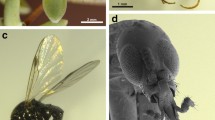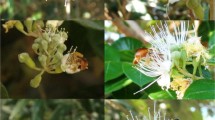Abstract
To test whether the nectarless flowers of Cypripedium tibeticum attract pollinators through mimicry like the allied species C. macranthos var. rebunense, pollination biology of C. tibeticum was investigated in western China. Although C. tibeticum was also pollinated by bumble bee queens, i.e. Bombus lepidus , B. lucorum and B. hypnorum , no special, rewarding model plants were found in the habitat. Field experimentation confirmed that the flowers were self-compatible but insects were required to transfer orchid pollen to the stigma. Both Bombus queens and workers were visitors, but queens were much more frequent than workers and only queens were effective pollinators. Floral functional morphology analysis showed that it was large queens rather than small workers that fitted well with the flowers of C. tibeticum. With the faint sweet-fruity scent, the minor floral fragrance compound, ethyl acetate, probably plays a role in attracting bumble bees by food deception. The dark flowers with the inflated, trap-like labellum are hypothesized to mimic the nest site of queens. Therefore, bumble bee queens tend to be attracted by C. tibeticum through nest site mimic combined with food deception. Considering that the co-blooming flowers of C. flavum are pollinated by the Bombus workers, and C. smithii pollinated by a queen, we suggest that using the same bumblebees with different body sizes as the pollinators is the main reproductive isolation between interfertile C. tibeticum and C. flavum, while C. tibeticum and C. smithii tend to hybridize naturally.
Similar content being viewed by others
References
J. D. Ackerman (1986) ArticleTitleMechanisms and evolution of food-deceptive pollination systems in orchids Lindleyana 1 108–113
H. Bänziger H. Q. Sun Y. B. Luo (2005) ArticleTitlePollination of a slippery lady slipper orchid in south-west China: Cypripedium guttatum (Orchidaceae) Bot. J. Linn. Soc. 148 251–264 Occurrence Handle10.1111/j.1095-8339.2005.00400.x
P. M. Catling V. R. Catling (1991) ArticleTitleA synopsis of breeding systems and pollination in North American orchids Lindleyana 6 IssueID4 187–210
S. Cozzolino A. Widmer (2005) ArticleTitleOrchid diversity: an evolutionary consequence of deception? Trends Ecol. Evol. 20 IssueID9 487–494 Occurrence Handle16701425 Occurrence Handle10.1016/j.tree.2005.06.004
P. Cribb (1997) The genus Cypripedium Timber Press Portland, Oregon, USA
A. Dafni Y. Ivri (1981) ArticleTitleFloral mimicry between Orchis israelitica Baumann and Dafni (Orchidaceae) and Bellevalia flexuosa Boiss (Liliaceae) Oecologia 49 229–232 Occurrence Handle10.1007/BF00349193
A. Dafni Y. Ivri N. B. M. Brantjes (1981) ArticleTitlePollination of Serapias vomeracea Briq. (Orchida-ceae) by imitation of holes for sleeping solitary male bees (Hymenoptera) Acta. Bot. Neerl. 30 69–73
A. Dafni (1984) ArticleTitleMimicry and deception in pollination Annual Rev. Ecol. Syst. 15 259–278 Occurrence Handle10.1146/annurev.es.15.110184.001355
A. Dafni (1987) Pollination in Orchis and related genera: evolution from reward to deception J. Arditti (Eds) Orchid Biology: reviews and perspectives, IV Cornell University Press Ithaca and London 79–104
R. W. Davis (1986) ArticleTitleThe pollination biology of Cypripedium acaule (Orchidaceae) Rhodora 88 445–450
R. L. Dressler (1993) Phylogeny and classification of the orchid family Cambridge University Press Cambridge, UK
S. D. Johnson (1994) ArticleTitleEvidence for Batesian mimicry in a butterfly pollinated orchid Biol. J. Linn. Soc. 53 91–104 Occurrence Handle10.1006/bijl.1994.1062
S. D. Johnson (2000) ArticleTitleBatesian mimicry in the non-rewarding orchid Disa pulchra, and its consequences for pollinator behaviour Biol. J. Linn. Soc. 71 119–132 Occurrence Handle10.1006/bijl.1999.0430
Li P., Tang S. Y., Dong L., Kou Y., Perner H., Luo Y. B. (2005a) Temperate paradise: orchids in the Huanglong valley. Orchid Review 113: 154–159.
Li P., Tang S. Y., Dong L., Luo Y. B., Kou Y., Yang X. Q., Perner H. (2005b) Species diversity and flowering phenology of Orchidaceae in Huanglong valley, Sichuan. Biodiversity Science 13(3): 255–261.
L. A. Nilsson (1979) ArticleTitleAnthecological studies of the lady's slipper, Cypripedium calceolus (Orchidaceae) Bot. Notiser 132 329–347
Nilsson L. A. (1983a) Anthecology of Orchis mascula (Orchidaceae). Nord. J. Bot. 3: 157–179.
Nilsson L. A. (1983b), Mimesis of bellflower (Campanula) by the red helleborine orchid Cephelanthera rubra. Nature 305: 799–800.
L. A. Nilsson (1992) ArticleTitleOrchid pollination biology Trends Ecol. Evol. 7 IssueID8 255–259 Occurrence Handle10.1016/0169-5347(92)90170-G
M. Proctor P. Yeo A. Lack (1996) The natural history of pollination Timber Press Portland, Oregon, USA
Y. Sapir A. Shmida G. Ne'eman (2005) ArticleTitlePollination of Oncocyclus irises (Iris: Iridaceae) by night-sheltering male bees Pl. Biol. 7 417–424 Occurrence Handle1:STN:280:DC%2BD2MzmslCgtQ%3D%3D Occurrence Handle10.1055/s-2005-837709
F. P. Schiestl (2005) ArticleTitleOn the success of a swindle: pollination by deception in orchids Naturwissenschaften 92 255–264 Occurrence Handle15931514 Occurrence Handle1:CAS:528:DC%2BD2MXmtVSmsLg%3D Occurrence Handle10.1007/s00114-005-0636-y
V. Simonds C. M. S. Plowright (2004) ArticleTitleHow do bumblebees first find flowers?. Unlearned approach responses and habituation Animal Behavior 67 379–386 Occurrence Handle10.1016/j.anbehav.2003.03.020
W. P. Stoutamire (1967) ArticleTitleFlower biology of the lady's slippers (Orchidaceae: Cypripedium) Michigan Botanist 3 107–119
N. Sugiura F. Taketoshi I. Ken K. Kenji (2001) ArticleTitleFlowering phenology, pollination, and fruit set of Cypripedium macranthos var. rebunense, a threatened lady's slipper (Orchidaceae) J. Pl. Res. 114 171–178 Occurrence Handle10.1007/PL00013980
N. Sugiura M. Goubara K. Kitamura K. Inoue (2002) ArticleTitleBumblebee pollination of Cypripedium macranthos var. rebunense (Orchidaceae): a possible case of floral mimicry of Pedicularis schistostegia (Orobanchiaceae) Pl. Syst. Evol. 235 189–195 Occurrence Handle10.1007/s00606-002-0229-6
L. B. Thien P. Bernhardt G. W. Gibbs O. M. Pellmyr G. Bergstrom I. Groth G. McPherson (1985) ArticleTitleThe pollination of Zygogynum (Winteraceae) by a moth, Sabatinca (Micropterigidae): an ancient association? Science 227 540–542 Occurrence Handle1:CAS:528:DyaL2MXht1yqtL8%3D Occurrence Handle10.1126/science.227.4686.540
N. A. Cingel ParticleVan der (2001) An atlas of orchid pollination Balkema A. A. Rotterdam, Netherland
Author information
Authors and Affiliations
Corresponding author
Rights and permissions
About this article
Cite this article
Li, P., Luo, Y.B., Bernhardt, P. et al. Deceptive pollination of the Lady's Slipper Cypripedium tibeticum (Orchidaceae). Plant Syst. Evol. 262, 53–63 (2006). https://doi.org/10.1007/s00606-006-0456-3
Received:
Accepted:
Published:
Issue Date:
DOI: https://doi.org/10.1007/s00606-006-0456-3




